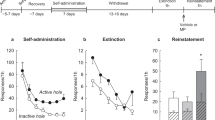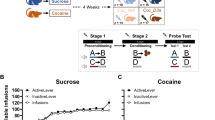Abstract
The simultaneous i.v. administration of heroin and cocaine, called “speedball,” is often reported clinically, and identification of effective pharmacotherapies for polydrug abuse is a continuing challenge. This study compared the effects of treatment using combinations of dopamine and opioid antagonists with each antagonist alone on speedball self-administration by rhesus monkeys. Speedballs (0.01 mg/kg/inj cocaine and 0.0032 mg/kg/inj heroin) and food (1 g banana pellets) were available in four daily sessions on a second-order schedule of reinforcement [FR4 (VR16:S)]. Monkeys were treated for 10 days with saline or ascending 1:10 dose combinations of the dopamine antagonist flupenthixol and the opioid antagonist quadazocine. The combination of flupenthixol (0.018 mg/kg/day) + quadazocine (0.18 mg/kg/day) significantly reduced speedball self-administration in comparison to the saline treatment baseline (p < .05), whereas, the same doses of each antagonist alone had no significant effect on speedball-maintained responding. Treatment with 0.018 mg/kg/day flupenthixol + 0.18 mg/kg/day quadazocine produced a 3-fold rightward shift in the speedball (3:1 cocaine-heroin combination) dose-effect curve. Food-maintained responding was similar during treatment with saline and with flupenthixol + quadazocine combinations. These findings suggest that medication mixtures designed to target both the stimulant and opioid component of the speedball combination, may be an effective approach to polydrug abuse treatment.
Similar content being viewed by others
Log in or create a free account to read this content
Gain free access to this article, as well as selected content from this journal and more on nature.com
or
References
Bertalmio AJ, Woods JA . (1989): Reinforcing effect of alfentanil is mediated by mu opioid receptors: Apparent PA2 analysis. J Pharmacol Exp Ther 251: 455–460
Bertalmio AJ, Woods JH . (1987): Differentiation between mu and kappa receptor-mediated effects in opioid drug discrimination: Apparent PA2 analysis. J Pharmacol Exp Ther 243: 591–597
Caine SB, Koob GF . (1994): Effects of dopamine D1 and D2 antagonists on cocaine self-administration under different schedules of reinforcement in the rat. J Pharmacol Exp Ther 270: 209–218
Condelli WS, Fairbank JA, Dennis ML, Rachal JV . (1991): Cocaine use by clients in methadone programs: Significance, scope, and behavioral interventions. J Subst Abuse Treat 8: 203–212
Corrigall WA, Coen KM . (1991): Cocaine self-administration is increased by both D1 and D2 dopamine antagonists. Pharmacol Biochem Behav 39: 799–802
Dykstra LA, Doty P, Johnson AB, Picker MJ . (1992): Discriminative stimulus properties of cocaine, alone and in combination with buprenorphine, morphine and naltrexone. Drug Alc Depend 30: 227–234
Ettenberg A, Pettit HO, Bloom FE, Koob GF . (1982): Heroin and cocaine intravenous self-administration in rats: Mediation by separate neural systems. Psychopharmacology (Berl) 78: 204–209
Foltin RW, Fischman MW . (1992): The cardiovascular and subjective effects of intravenous cocaine and morphine combinations in humans. J Pharmacol Exp Ther 261: 623–632
Fudala PJ, Yu E, Macfadden W, Boardman C, Chiang CN . (1998): Effects of buprenorphine and naloxone in morphine-stabilized opioid addicts. Drug Alcohol Depend 50: 1–8
Gastfriend DR, Mendelson JH, Mello NK, Teoh SK, Reif S . (1993): Buprenorphine pharmacotherapy for concurrent heroin and cocaine dependence. Am J Addict 2: 269–278
Hemby SE, Co C, Dworkin SI, Smith EJ . (1999): Synergistic elevations in nucleus accumbens extracellular dopamine concentrations during self-administration of cocaine/heroin combinations (Speedball) in rats. J Pharmacol Exp Ther 288: 274–280
Hemby SE, Smith JE, Dworkin SI . (1996): The effects of eticlopride and naltrexone on responding maintained by food, cocaine, heroin and cocaine/heroin combinations in rats. J Pharmacol Exp Ther 277: 1247–1258
ILAR-NRC . (1996): Guide for the Care and Use of Laboratory Animals. Washington, DC, National Academy Press
Johnson RE, Jaffe JH, Fudala PJ . (1992): A controlled trial of buprenorphine treatment for opioid dependence. JAMA 267: 2750–2755
Kleven MS, Woolverton WL . (1990): Effects of continuous infusions of SCH 23390 on cocaine- or food-maintained behavior in rhesus monkeys. Behav Pharmacol 1: 365–373
Kosten TR, Kleber HD, Morgan C . (1989a): Role of opioid antagonists in treating intravenous cocaine abuse. Life Sci 44: 887–892
Kosten TR, Kleber HD, Morgan C . (1989b): Treatment of cocaine abuse with buprenorphine. Biol Psychiatry 26: 170–172
Lamas X, Negus SS, Gatch MB, Mello NK . (1998): Effects of heroin/cocaine combinations in rats trained to discriminate heroin or cocaine from saline. Pharmacol Biochem Behav 60: 357–364
Line SW . (1987): Environmental enrichment for laboratory primates. JAVMA 90: 854–859
Loimer N, Presslich O, Grunberger J, Linzmayer L . (1991): Combined naloxone/methadone preparations for opiate substitution therapy. J Subst Abuse Treat 8: 157–160
Mello NK, Bree MP, Mendelson JH . (1983): Comparison of buprenorphine and methadone effects on opiate self-administration in primates. J Pharmacol Exp Ther 225: 378–386
Mello NK, Kamien JB, Lukas SE, Mendelson JH, Drieze JM, Sholar JW . (1993a): Effects of intermittent buprenorphine administration on cocaine self-administration by rhesus monkeys. J Pharmacol Exp Ther 264: 530–541
Mello NK, Lukas SE, Kamien JB, Mendelson JH, Drieze J, Cone EJ . (1992): The effects of chronic buprenorphine treatment on cocaine and food self-administration by rhesus monkeys. J Pharmacol Exp Ther 260: 1185–1193
Mello NK, Lukas SE, Mendelson JH, Drieze J . (1993b): Naltrexone-buprenorphine interactions: Effects on cocaine self-administration. Neuropsychopharmacology 9: 211–224
Mello NK, Mendelson JH . (1980): Buprenorphine suppresses heroin use by heroin addicts. Science 27: 657–659
Mello NK, Mendelson JH . (1995): Buprenorphine treatment of cocaine and heroin abuse. In Cowan A, Lewis J.W. (eds), Buprenorphine: Combatting Drug Abuse with a Unique Opioid. New York, John Wiley & Sons, Inc., pp 241–287
Mello NK, Mendelson JH, Bree MP, Lukas SE . (1989): Buprenorphine suppresses cocaine self-administration by rhesus monkey. Science 245: 859–862
Mello NK, Mendelson JH, Bree MP, Lukas SE . (1990): Buprenorphine and naltrexone effects on cocaine self-administration by rhesus monkeys. J Pharmacol Exp Ther 254: 926–939
Mello NK, Negus SS . (1996): Preclinical evaluation of pharmacotherapies for treatment of cocaine and opiate abuse using drug self-administration procedures. Neuropsychopharmacology 14: 375–424
Mello NK, Negus SS . (1998): The effects of buprenorphine on self-administration of cocaine and heroin “speedball” combinations and heroin alone by rhesus monkeys. J Pharmacol Exp Ther 285: 444–456
Mello NK, Negus SS, Lukas SE, Mendelson JH, Sholar JW, Drieze J . (1995): A primate model of polydrug abuse: Cocaine and heroin combinations. J Pharmacol Exp Ther 274: 1325–1337
Mendelson J, Jones RT, Fernandez I, Welm S, Melby AK, Baggott MJ . (1996): Buprenorphine and naloxone interactions in opiate-dependent volunteers. Clin Pharmacol Ther 60: 105–114
Mendelson J, Jones RT, Welm S, Baggott M, Fernandez I, Melby AK, Nath RP . (1999): Buprenorphine and naloxone combinations: The effects of three dose ratios in morphine-stabilized, opiate-dependent volunteers. Psychopharmacology (Berl) 141: 37–46
Mendelson J, Jones RT, Welm S, Brown J, Batki SL . (1997): Buprenorphine and naloxone interactions in methadone maintenance patients. Biol Psychiatry 41: 1095–1101
Mendelson JH, Mello NK . (1996): Management of cocaine abuse and dependence. N Engl J Med 334: 965–972
Negus SS, Burke TF, Medzihradsky F, Woods JH . (1993): Effects of opioid agonists selective for mu, kappa and delta opioid receptors on schedule-controlled responding in rhesus monkeys: Antagonism by quadazocine. J Pharmacol Exp Ther 267: 896–903
Negus SS, Gatch MB, Mello NK . (1998a): Discriminative stimulus effects of a cocaine/heroin “speedball” combination in rhesus monkeys. J Pharmacol Exp Ther 285: 1123–1136
Negus SS, Gatch MB, Mello NK . (1998b): Effects of mu opioid agonists alone and in combination with cocaine and d-amphetamine in rhesus monkeys trained to discriminate cocaine. Neuropsychopharmacology 18: 325–338
Negus SS, Mello NK, Lamas X, Mendelson JH . (1996): Acute and chronic effects of flupenthixol on the discriminative stimulus and reinforcing effects of cocaine in rhesus monkeys. J Pharmacol Exp Ther 278: 879–890
Negus SS, Mello NK, Lukas SE, Mendelson JH . (1995): Diurnal patterns of cocaine and heroin self-administration in rhesus monkeys responding under a schedule of multiple daily sessions. Behav Pharmacol 6: 763–775
National Institute on Drug Abuse (NIDA). (1998): Epidemiologic Trends in Drug Abuse. Washington, DC, NIH Publ. No. 98–4300, p 79
Preston KL, Bigelow GE, Liebson IA . (1989): Antagonist effects of nalbuphine in opioid-dependent humans. J Pharmacol Exp Ther 248: 929–937
Reus VI . (1993): Rational polypharmacy in the treatment of mood disorders. J Clin Psychiatry 5: 91–100
Richardson NR, Smith AM, Roberts DCS . (1994): A single injection of either flupenthixol decanoate or haloperidol decanoate produces long-term changes in cocaine self-administration in rats. Drug Alcohol Dep 36: 23–25
Rowlett JK, Spealman RD . (1998): Opioid enhancement of the discriminative stimulus effects of cocaine: Evidence for involvement of μ and δ opioid receptors. Psychopharmacology 140: 217–224
Rowlett JK, Wilcox KM, Woolverton WL . (1998): Self-administration of cocaine-heroin combinations by rhesus monkeys: Antagonism by naltrexone. J Pharmacol Exp Ther 286: 61–69
Rowlett JK, Woolverton WL . (1997): Self-administration of cocaine and heroin combinations by rhesus monkeys responding under a progressive-ratio schedule. Psychopharmacology (Berl) 133: 363–371
Schöpf J, Baumann P, LeMarchand T, Rey M . (1989): Treatment of endogenous depressions resistant to tricyclic antidepressants or related drugs by lithium addition. Pharmacopsychiatry 22: 183–187
Schottenfeld RS, Pakes JR, Ziedonis D, Kosten TR . (1993): Buprenorphine: Dose-related effects on cocaine and opioid use in cocaine-abusing opioid-dependent humans. Biol Psychiatry 3: 66–74
Schottenfeld RS, Pakes JR, Oliveto A, Ziedonis D, Kosten TR . (1997): Buprenorphine vs. methadone maintenance treatment for concurrent opioid dependence and cocaine abuse. Arch Gen Psychiatry 54: 713–720
Schütz CG, Vlahov D, Anthony JC, Graham NMH . (1994): Comparison of self-reported injection frequencies for past 30 days and 6 months among intravenous drug users. J Clin Epidemiol 47: 191–195
Spealman RD, Bergman J . (1992): Modulation of the discriminative stimulus effects of cocaine by mu and kappa opioids. J Pharmacol Exp Ther 261: 607–615
Thase ME, Rush AJ . (1995): Treatment-resistant depression. In Bloom E.K. Kupfer D.J.(eds), Psychopharmacology: The Fourth Generation of Progress. New York, Raven Press, Ltd., pp 1081–1097
Walsh SL, Sullivan JT, Preston KL, Garner J . (1996): The effects of naltrexone on response to i.v. cocaine, hydromorphone and their combination in humans. J Pharmacol Exp Ther 279: 524–538
Weinhold LL, Preston KL, Farre M, Liebson IA, Bigelow GE . (1992): Buprenorphine alone and in combination with naloxone in non-dependent humans. Drug Alc Depend 30: 263–274
Winger G . (1994): Dopamine antagonist effects on behavior maintained by cocaine and alfentanil in rhesus monkeys. Behav Pharmacol 5: 141–152
Wolkowitz OM . (1993): Rational polypharmacy in schizophrenia. Ann Clin Psychiatry 5: 79–90
Acknowledgements
We thank Nicolas Diaz-Migoyo and Amy Calvert for their technical assistance. We are grateful to Elizabeth Hall, D.V.M. for veterinary assistance and to Bruce Stephen for his contributions to the data analysis. Preliminary data were reported at the 1998 annual meeting of the College on Problems of Drug Dependence and the American College of Neuropsychopharmacology. This research was supported in part by KO5 DA-00101, P50 DA-04059, and RO1 DA-02519 from the National Institute on Drug Abuse, NIH.
Author information
Authors and Affiliations
Rights and permissions
About this article
Cite this article
Mello, N., Negus, S. Effects of Flupenthixol and Quadazocine on Self-Administration of Speedball Combinations of Cocaine and Heroin by Rhesus Monkeys. Neuropsychopharmacol 21, 575–588 (1999). https://doi.org/10.1016/S0893-133X(99)00056-1
Received:
Revised:
Accepted:
Issue date:
DOI: https://doi.org/10.1016/S0893-133X(99)00056-1
Keywords
This article is cited by
-
Effects of d-Amphetamine and Buprenorphine Combinations on Speedball (Cocaine+Heroin) Self-Administration by Rhesus Monkeys
Neuropsychopharmacology (2007)
-
Cocaine and heroin (‘speedball’) self-administration: the involvement of nucleus accumbens dopamine and μ-opiate, but not δ-opiate receptors
Psychopharmacology (2005)



